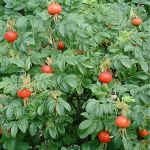| Common Name: |
Hedgehog Rose |
| Other Names: |
Japanese Rose, Ramanas Rose, Tomato Rose |
| Botanical Name: |
Rosa Rugosa |
| Genus: |
Rosa |
| Family: |
Rosaceae |
| Native Location: |
E Russia, N China, Japan and Korea |
| Cultivation: |
Well-drained, moist, rich neutral to slightly acid soil (including clay) in sun. Rosa rubiginosa enjoys dry, calcareous conditions; R. laevigata thrives in poor soils, R. rugosa tolerates dry, sandy or coastal conditions. Remove dead and damaged wood, and prune lightly in early winter, removing weak growths. Most species and old roses flower on the previous year's growth and should not be cut back hard. Rose hips, especially of R. rugosa, may be damaged by birds. Leaves may be damaged by blackspot, downy mildew, rust, viruses, and sawfly. Buds and flowers are prone to attack by aphids. |
| Propagation: |
By seed sown in autumn (species only); by budding in summer; by hardwood cuttings in autumn. |
| Harvest: |
Petals are collected when flowers first open and distilled for oil and rose water, used fresh for syrups, crushed into pastes, or dried for use in decoctions. Fruits are picked when ripe and used fresh or dried in decoctions, or made into syrups and candy. Seeds (R. rubiginosa) from ripe fruits are processed commercially for oil extraction. |
| Height: |
1-2.5m (3-8ft) |
| Width: |
1-2.5m (3-8ft) |
| Warning: |
Hips and seeds contain irritant hairs. R. canina and R. rubiginosa are subject to statuatory control as weeds in some countries, notably in parts of Australia and the USA. |
| Variants: |
Alba
Has single, white flowers, 9cm (3½in) across, opening from pink-flushed buds. |
Rubra
Has purple-pink flowers. |
|
| Hardiness: |
Z2-8 |
| Parts Used: |
Flowers (mei gui hua), petals, fruits. |
| Properties: |
An aromatic, tonic herb that stimulates the liver, improves circulation, and acts as an antidote in antimony poisoning (flowers). |
| Medicinal Uses: |
Internally for poor appetits and digestion, and menstrual complaints arising from constrained liver energy (flowers). Combined with Leonurus cardiaca (See, Motherwort) or L. sibiricus (See, Chinese Motherwort) for heavy menstruation. |
| Culinary Uses: |
Petals are crystalized, made into jams, syrup, and spirit (mei kuei lu), and used to make rose congou tea. Fruits are made into puree, jam, jelly, wine, soup, and tea. |
| Economic Uses: |
Fruits are an important source of vitamin C and flavonoids for food supplements, especially in the USA. |
| Bibliography: |
The Encyclopedia or Herbs by Deni Bown Copyright © 1995, 2001 Dorling Kindersley Limited. pp. 346-348 |
